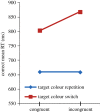Feature-based attention: it is all bottom-up priming
- PMID: 24018717
- PMCID: PMC3758198
- DOI: 10.1098/rstb.2013.0055
Feature-based attention: it is all bottom-up priming
Abstract
Feature-based attention (FBA) enhances the representation of image characteristics throughout the visual field, a mechanism that is particularly useful when searching for a specific stimulus feature. Even though most theories of visual search implicitly or explicitly assume that FBA is under top-down control, we argue that the role of top-down processing in FBA may be limited. Our review of the literature indicates that all behavioural and neuro-imaging studies investigating FBA suffer from the shortcoming that they cannot rule out an effect of priming. The mere attending to a feature enhances the mandatory processing of that feature across the visual field, an effect that is likely to occur in an automatic, bottom-up way. Studies that have investigated the feasibility of FBA by means of cueing paradigms suggest that the role of top-down processing in FBA is limited (e.g. prepare for red). Instead, the actual processing of the stimulus is needed to cause the mandatory tuning of responses throughout the visual field. We conclude that it is likely that all FBA effects reported previously are the result of bottom-up priming.
Keywords: feature-based attention; priming, top-down control; selective attention.
Figures




Similar articles
-
Changing your mind: on the contributions of top-down and bottom-up guidance in visual search for feature singletons.J Exp Psychol Hum Percept Perform. 2003 Apr;29(2):483-502. doi: 10.1037/0096-1523.29.2.483. J Exp Psychol Hum Percept Perform. 2003. PMID: 12760630 Clinical Trial.
-
In search of exogenous feature-based attention.Atten Percept Psychophys. 2020 Jan;82(1):312-329. doi: 10.3758/s13414-019-01815-3. Atten Percept Psychophys. 2020. PMID: 31317395 Free PMC article. Clinical Trial.
-
Sources of top-down control in visual search.J Cogn Neurosci. 2009 Nov;21(11):2100-13. doi: 10.1162/jocn.2008.21173. J Cogn Neurosci. 2009. PMID: 19199412
-
Neural mechanism of priming in visual search.Atten Percept Psychophys. 2021 Feb;83(2):587-602. doi: 10.3758/s13414-020-02118-8. Atten Percept Psychophys. 2021. PMID: 32914342 Free PMC article. Review.
-
Is goal-directed attentional guidance just intertrial priming? A review.J Vis. 2013 Jul 1;13(3):14. doi: 10.1167/13.3.14. J Vis. 2013. PMID: 23818660 Review.
Cited by
-
Conscious and unconscious memory systems.Cold Spring Harb Perspect Biol. 2015 Mar 2;7(3):a021667. doi: 10.1101/cshperspect.a021667. Cold Spring Harb Perspect Biol. 2015. PMID: 25731765 Free PMC article. Review.
-
The Nature of Unconscious Attention to Subliminal Cues.Vision (Basel). 2019 Aug 1;3(3):38. doi: 10.3390/vision3030038. Vision (Basel). 2019. PMID: 31735839 Free PMC article. Review.
-
Pre-stimulus Alpha Activity Modulates Face and Object Processing in the Intra-Parietal Sulcus, a MEG Study.Front Hum Neurosci. 2022 May 2;16:831781. doi: 10.3389/fnhum.2022.831781. eCollection 2022. Front Hum Neurosci. 2022. PMID: 35585993 Free PMC article.
-
The interaction of feature and space based orienting within the attention set.Front Integr Neurosci. 2014 Jan 30;8:9. doi: 10.3389/fnint.2014.00009. eCollection 2014. Front Integr Neurosci. 2014. PMID: 24523682 Free PMC article.
-
Learning changes the attentional status of prospective memories.Psychon Bull Rev. 2016 Oct;23(5):1483-1490. doi: 10.3758/s13423-016-1008-7. Psychon Bull Rev. 2016. PMID: 26892228 Free PMC article.
References
-
- Eriksen CW, Hoffman J. 1973. The extent of processing of noise elements during selective encoding from visual displays. Percept. Psychophys. 40, 225–240 (doi:10.3758/BF03211502) - DOI - PubMed
-
- Hoffman JE. 1975. Hierarchical stages in the processing of visual information. Percept. Psychophys. 18, 348–354 (doi:10.3758/BF03211211) - DOI
-
- Posner MI, Snyder CRR, Davidson BJ. 1980. Attention and the detection of signals. J. Exp. Psychol. Gen. 109, 160–174 (doi:10.1037/0096-3445.109.2.160) - DOI - PubMed
-
- Posner MI. 1980. Orienting of attention. Q. J. Exp. Psychol. 32, 3–25 (doi:10.1080/00335558008248231) - DOI - PubMed
-
- Theeuwes J. 2010. Top-down and bottom-up control of visual selection. Acta Psychol. 123, 77–99 (doi:10.1016/j.actpsy.2010.02.006) - DOI - PubMed
Publication types
MeSH terms
LinkOut - more resources
Full Text Sources
Other Literature Sources

